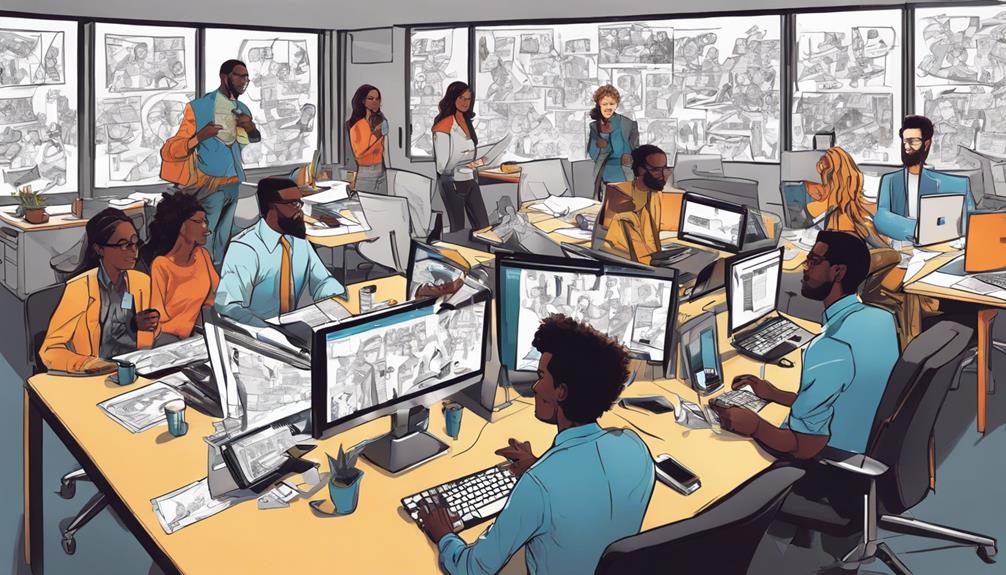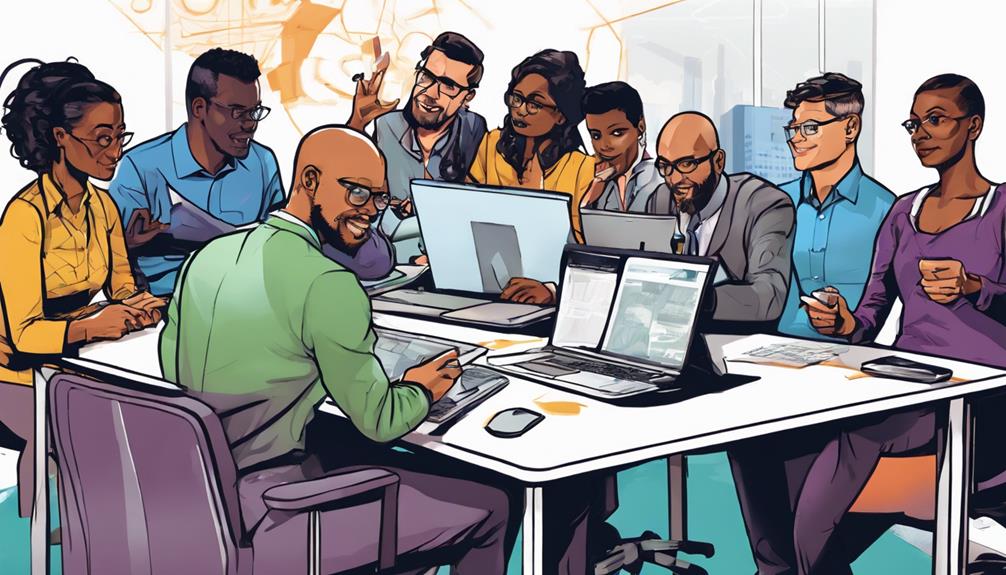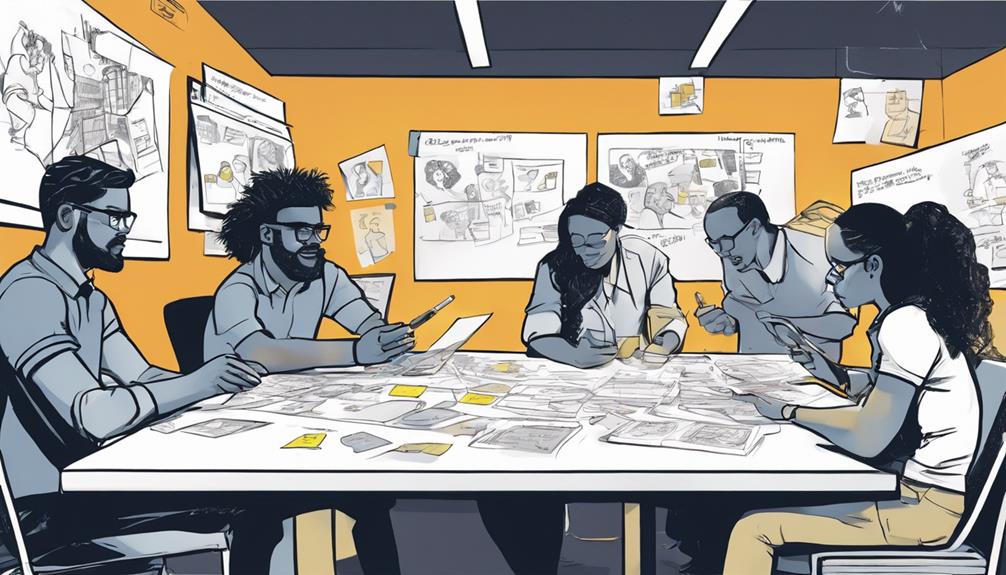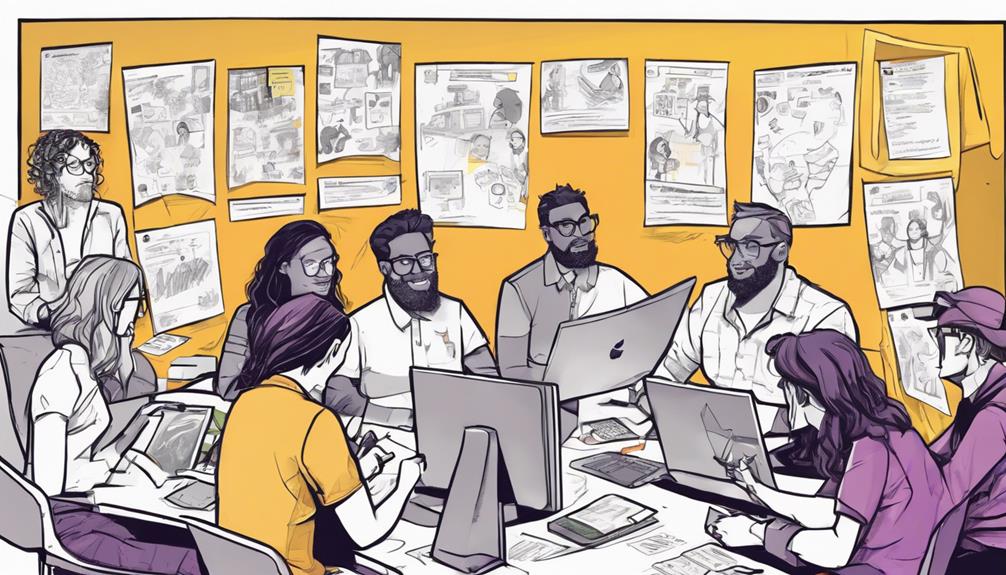Elevate your innovation prowess with IBM Enterprise Design Thinking. Prioritize user outcomes, diverse teams, and rapid prototyping. Gain digital credentials and master user-centered solutions. Empower your team to drive business growth and foster collaboration. Utilize JavaScript for quick iterations and problem-solving. Start your journey to revolutionize user-centric solutions!
Key Takeaways
- Prioritize user outcomes and restless reinvention.
- Harness diverse empowered teams for innovation.
- Utilize the Loop visualization for continuous improvement.
- Implement hills and playbacks for user-centered design.
- Drive business growth with differentiated outcomes.
Principles of Enterprise Design Thinking
Explore the foundational principles of Enterprise Design Thinking that drive innovation and user-centered solutions in complex business environments.
Design thinking in the context of Enterprise Design Thinking revolves around user outcomes, restless reinvention, and the power of diverse empowered teams to deliver breakthrough solutions.
The Loop visualization, a key component of the IBM model, symbolizes a continuous cycle of observing, reflecting, and making, which is instrumental in minimizing risks and fostering breakthrough innovations.
Successful implementation of Enterprise Design Thinking hinges on essential elements like hills that outline user outcomes, playbacks to mark milestones, and sponsor users who provide direct insights into user needs.
By adhering to these principles and practices, organizations can drive innovation, foster collaboration, and deliver solutions that are truly user-centered in even the most intricate business landscapes.
The emphasis on user outcomes, diverse empowered teams, and the Loop visualization underscores the transformative power of Enterprise Design Thinking in driving impactful innovation within organizations.
Applying Design Thinking Methodology

To effectively implement design thinking methodology, focus on user needs, rapid prototyping, and collaboration within diverse teams.
Design thinking courses can equip your team with the necessary skills to understand user personas and prioritize user needs. By aligning the team around user-centered design, you guarantee that solutions are tailored to meet the users' requirements effectively.
Rapid prototyping, especially when JavaScript enabled, allows for quick validation of ideas and helps in iterating towards the best possible solution efficiently.
Collaboration within a diverse team brings different perspectives to the table, fostering creativity and innovation. By embracing the principles of design thinking, you can enhance the overall user experience and drive business growth.
Benefits of IBM's Approach

IBM's approach enhances innovation and creativity by prioritizing a user-centered design methodology. By focusing on user outcomes, IBM's design thinking methodology safeguards that solutions directly address real user needs, leading to improved problem-solving skills and increased user satisfaction.
Additionally, the emphasis on iterative prototyping and testing allows for quick feedback loops, enabling teams to refine their ideas efficiently.
Team collaboration is also a key benefit of IBM's approach, as it encourages diverse teams to come together and leverage their unique perspectives and skills. This collaborative environment fosters creativity and helps drive towards breakthrough solutions that make a real impact.
Ultimately, by embracing a user-centered approach and empowering cross-functional teams, IBM's design thinking methodology not only safeguards the quality of solutions but also drives business growth through the delivery of differentiated outcomes.
Digital Credentials and Training

Let's explore the process of verifying digital credentials and the specific details of IBM's training program. These points will shed light on how you can showcase your design thinking skills and enhance your expertise in facilitation and problem-solving.
Credentials Verification Process
You can earn digital credentials in Enterprise Design Thinking from IBM by completing specific training and demonstrating proficiency in design thinking techniques and facilitation skills.
To verify your credentials, IBM has a thorough verification process in place:
- Training Completion: Successfully finish the required training modules covering design thinking methodologies and facilitation skills.
- Exercises and Assessments: Engage in exercises and assessments to demonstrate your understanding and application of key design thinking concepts.
- Skills Demonstration: Showcase your proficiency in design thinking techniques and facilitation skills through practical demonstrations.
- Instructor Mastery: For those pursuing Instructor Badges, passing exams and showcasing mastery in lecture material and toolkit methods are essential steps.
Training Program Details
To acquire digital credentials in Enterprise Design Thinking from IBM, you engage in a thorough training program focusing on mastering design thinking techniques and showcasing problem-solving skills in real-world scenarios.
The design thinking courses and certifications offered empower you to create user-centric solutions by focusing on user needs and leveraging information architecture effectively.
This training equips you with a powerful tool for building products that resonate with users.
Community Insights and Best Practices

You'll discover how Servant Leadership in Enterprise Design Thinking can elevate user and customer needs, fostering a culture of empathy and understanding.
By encouraging collaboration and sharing information architecture with developers, teams can enhance their innovative capabilities and achieve better project outcomes.
Embracing innovation within Enterprise Design Thinking paves the way for the creation of groundbreaking service delivery models that can revolutionize business solutions.
Servant Leadership Benefits
Emphasizing the importance of servant leadership in Enterprise Design Thinking ensures a user-centric approach that drives project success. Servant leadership encourages prioritizing user needs, promoting collaboration, improving teamwork, enhancing project outcomes, fostering innovation, and effective problem-solving.
Prioritizing User Needs: By focusing on understanding and meeting user requirements, servant leadership guarantees that solutions are tailored to address real user challenges effectively.
Promoting Collaboration: Servant leaders cultivate an environment where team members share information, ideas, and feedback freely, leading to a more cohesive and productive team dynamic.
Improving Teamwork: Through servant leadership, teams work together cohesively towards a common goal, leveraging each other's strengths and expertise to achieve optimal project results.
Fostering Innovation: Servant leadership inspires creativity and out-of-the-box thinking, enabling teams to develop innovative solutions and unique service delivery models that set them apart in the market.
Collaboration for Innovation
Prioritizing user needs through servant leadership in Enterprise Design Thinking sets the foundation for fostering collaboration and driving innovation within the community for best results. Collaboration is key in design thinking, as it brings together diverse perspectives to tackle complex problems and generate innovative solutions. Sharing information architecture with developers ensures alignment and smooth communication throughout the design process. Effective problem-solving strategies play a crucial role in scaling design thinking practices across large organizations, allowing for the continuous fostering of innovation. By implementing these strategies, businesses can create innovative service delivery models that drive growth and enhance user satisfaction. It is essential to measure the impact of design thinking on business solutions to evaluate its effectiveness and make informed decisions moving forward.
| Key Points | Actions |
|---|---|
| Collaboration | Bring together diverse perspectives |
| Design Thinking | Generate innovative solutions |
| Innovation | Drive growth and user satisfaction |
| Problem-Solving | Scale design thinking practices |
Getting Started With Enterprise Design Thinking

To begin implementing Enterprise Design Thinking within your organization, start by defining a clear problem statement that aligns with your business goals. This initial step sets the foundation for successful integration of design thinking principles.
Here are some key actions to kickstart your journey:
- Enroll in Design Thinking Courses: Invest in training for your team to familiarize them with the principles and methodologies of design thinking.
- Involve Users Early: Engage with users to understand their needs and pain points, ensuring that your products or solutions meet their requirements effectively.
- Encourage Cross-Functional Team Collaboration: Foster collaboration among diverse teams to bring different perspectives and expertise to the design process.
- Prototype with JavaScript: Utilize tools like JavaScript for rapid prototyping, enabling quick iterations and feedback gathering to refine your solutions effectively.
Frequently Asked Questions
What Are the Three Principles of Enterprise Design Thinking in Ibm?
To understand IBM's enterprise design thinking principles, focus on user outcomes, embrace rapid prototyping for constant evolution, and empower diverse teams for innovative breakthroughs. These principles drive user-centered solutions and foster creative collaboration.
How to Get IBM Badges?
To get IBM badges, you attend training, complete exercises, and showcase skills like collaboration, communication, empathy, and problem-solving. It's a bit like climbing Everest, but with design thinking. So, grab your gear and get ready to conquer!
What Is the IBM Model of Design Thinking?
The IBM model of design thinking focuses on user-centric solutions, employing the Loop visualization for observing, reflecting, and making. It aims to reduce risk through incremental changes, using Hills for user-centric outcomes and playbacks for milestones.
What Is Enterprise Design Thinking Ibm?
So, what's all the fuss about IBM's Enterprise Design Thinking? Well, it's your ticket to excellent problem-solving! Align teams, research users, brainstorm, prototype – all to innovate like a pro!
Conclusion
So next time you want to innovate like a pro, just remember: IBM's Enterprise Design Thinking is your ticket to success.
Who knew that thinking outside the box could be so structured and effective? Say goodbye to chaos and hello to organized creativity.
With IBM's approach, you'll be revolutionizing your business in no time.
So go ahead, take the leap and see where Enterprise Design Thinking can take you!









